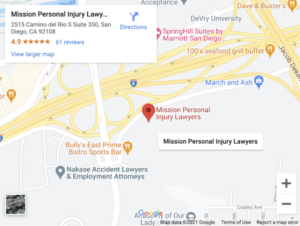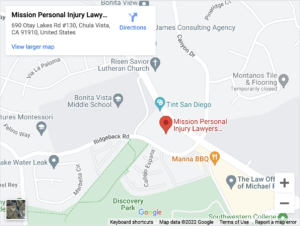
Whiplash gets a bad rap. Like soft tissue injuries, whiplash does not show up on x-rays. As a result, insurers sometimes treat whiplash like you faked it or made it up after your accident.
But whiplash is a real phenomenon when you experience rapid acceleration or deceleration. And it produces real injuries that can injure your soft tissue, nerves, and even your brain.
Learn about the causes of whiplash injuries and the compensation you can seek for a whiplash injury.
Table of Contents
What is the Anatomy of Your Neck?

Despite looking like two different structures, your neck and back both center around your spine. Your neck includes the seven cervical vertebrae at the top of your spine.
Each vertebra includes a solid body and processes extending off the body like wings. The body supports the wings as an anchor point for tendons in your neck.
When they align, the vertebrae support the weight of your head like a column. But they can also move relative to each other. When they move, the vertebrae provide the flexibility for you to turn and nod your head.
A disc sits between each pair of vertebrae. The discs provide a cushion between the vertebrae. They also allow the vertebrae to move smoothly instead of grinding against each other.
Ligaments hold the vertebrae together. The ligaments provide the elasticity and strength to hold the vertebrae as you move your neck.
Muscles overlie the bones and ligaments. The muscles move your head and neck. The muscles in your neck anchor through tendons to your vertebrae, skull, shoulder blades, ribs, and collarbones.
Your spinal cord runs through the spinal canal in your spine. Almost all of the nerves that connect your body and brain run through your neck.
Nerve roots branch off your spinal cord as it passes through your spine. Each vertebra has nerve roots next to it. The nerve roots for your shoulders, arms, hands, and fingers branch off the spinal cord in your neck.
How Does a Whiplash Injury Happen?
Whiplash results from acceleration and deceleration of your body and head. According to the laws of motion, an object that’s at rest will stay at rest until an outside force acts on it. Similarly, an object in motion will stay in motion until a force gets applied to it.
When your body accelerates or decelerates, it must pull your head along. Whether you speed up or slow down, the force to keep your head with your body comes from your neck. In other words, your neck pulls your head to a stop when your body stops. It also pulls your head to keep up with your body when accelerating.
This might not seem like much. But your head weighs 10 to 11 pounds. This is roughly equivalent to a 12-can case of soda. Imagine how much force you would need to stop a case of soda traveling at 40 miles per hour. Your neck exerts this same force on your head when you get into a car accident at that speed.
Whiplash and Hyperextension
Hyperextension happens when soft tissue gets stretched beyond its normal capacity. When your neck pulls on your head to stop its motion, your neck hyperextends.
Your neck is designed to extend. The vertebrae can separate as the neck extends.
But when your neck hyperextends, you can injure the soft tissue in your neck. Worse yet, the discs and vertebrae can move out of place and press on nerve roots. This can cause nerve pain that radiates out of your neck and into your body.
What Are Some Whiplash Injury Examples?
Whiplash injuries can take a few different forms depending on the tissue that gets damaged.
Neck Strain or Sprain
The most common whiplash injury is a strained or sprained neck. Neck strains happen when the muscles or tendons in your neck stretch or tear.
Symptoms of neck strain include:
- Pain
- Swelling
- Weakness
- Muscle spasms
- Stiff neck
A sprained neck happens when the ligaments in your neck, particularly those holding the cervical vertebrae, get stretched or torn.
Symptoms of a sprained neck include:
- Pain
- Swelling
- Limited neck motion
- Neck instability
- Bruises
- Popping sound at the time of injury
Both strains and sprains can heal on their own without surgery. Instead, your doctor will probably prescribe rest, ice, and anti-inflammatory drugs.
Disc Damage
When your neck hyperextends, the vertebrae separate. When you come to a rest, your neck compresses. This compression can damage the discs in your neck.
Each disc has a tough outer shell that surrounds a gel-like interior. You have a bulging disc when the outer shell remains intact but bows out. You have a herniated disc when the outer shell breaks down and allows the interior to protrude.
In either case, your neck can feel unstable and weak. The protrusion can press on nearby nerves and cause neck pain. In a worst-case situation, the protrusion presses on a nerve root, causing a nerve injury.
Fractured Vertebra
When the vertebrae come crashing together after getting hyperextended, they can fracture. A fractured cervical vertebra is a serious injury. If the vertebra dislocates, it can sever the spinal cord in your neck, causing paralysis or even death.
Concussion
A concussion is not a whiplash injury. But it can result from the same forces that cause whiplash.
Your brain can slide inside your skull when your head whips back and forth. The cerebrospinal fluid (CSF) surrounding your brain cushions the brain from hitting the skull.
But pressure from the CSF damages your brain and causes it to inflame. The swelling and increase in temperature cause a range of symptoms, including headache, confusion, and drowsiness.
How Do You Seek Compensation for a Whiplash Injury?
If you suffered whiplash in an accident caused by someone else’s negligence, you could seek injury compensation. For example, suppose that you were involved in a pedestrian accident where the driver failed to yield to you at a crosswalk. In that case, you can probably seek injury compensation for your whiplash injuries.
Whiplash can cause severe pain and keep you out of work while you heal. In some situations, it can lead to more severe symptoms like nerve pain or even paralysis. To discuss the compensation you can seek for your whiplash injury, contact or call Mission Personal Injury Lawyers at (619) 777-5555 to schedule a free consultation.


